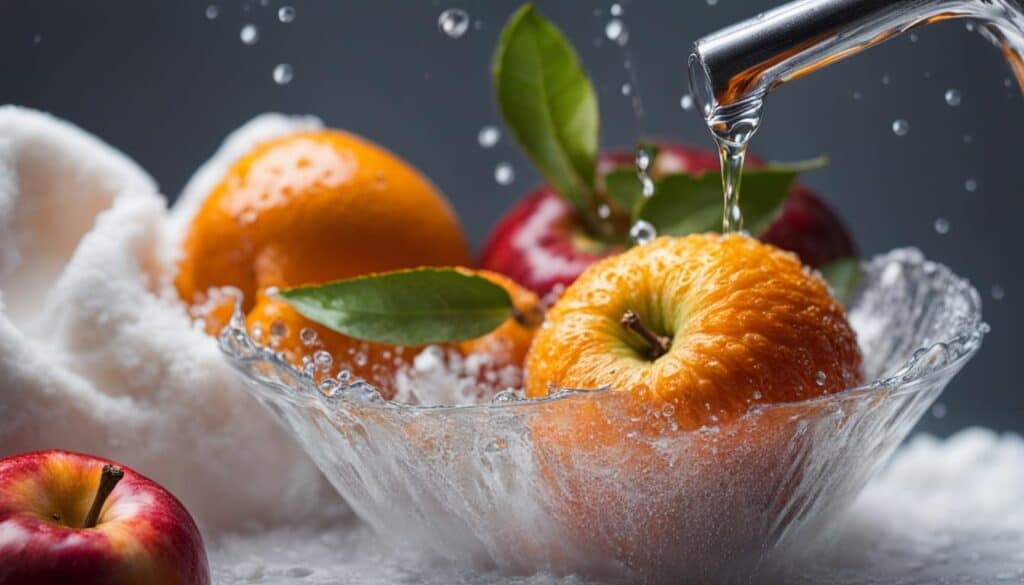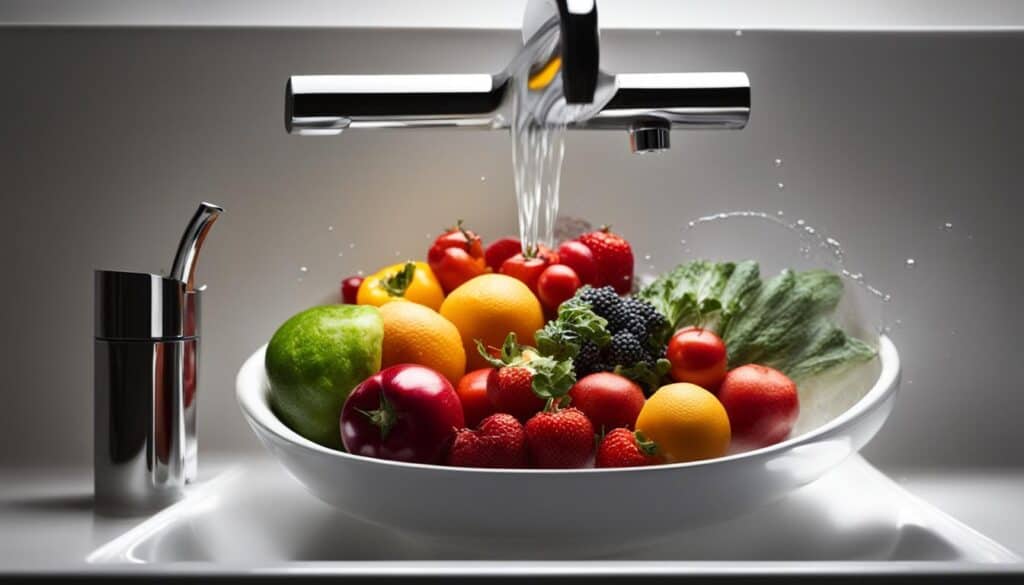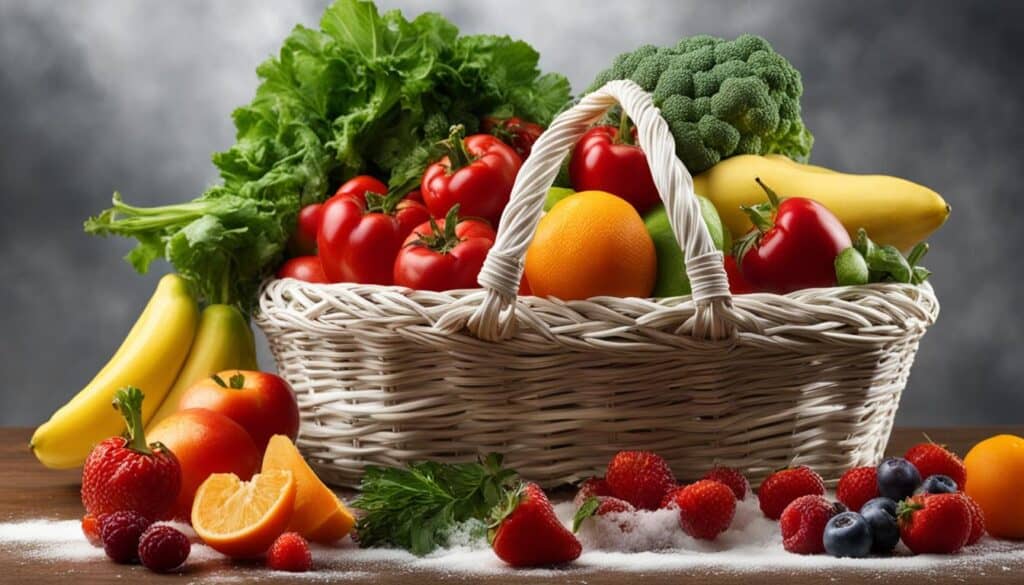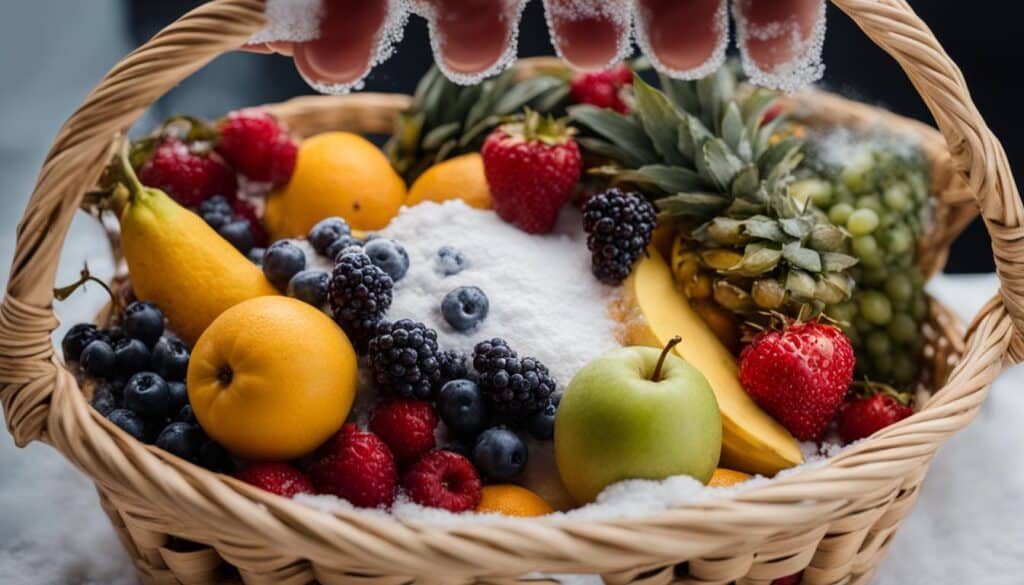Are you looking for a natural and effective way to clean your fruits? You might be surprised to learn that baking soda can be the answer! In this article, I will explain how you can use baking soda to clean your fruits and vegetables, providing you with a simple and affordable solution.
Key Takeaways:
- Using baking soda to clean fruits and vegetables is a natural and effective method.
- The recommended ratio is 1 teaspoon of baking soda per 2 cups of cold water.
- Soaking produce in a baking soda solution helps remove residue from the exterior.
- Washing produce with tap water alone can also significantly reduce pesticide residues.
- Consider buying organic produce or sourcing from pesticide-free farmers to minimize pesticide exposure.
The Benefits of Using Baking Soda to Clean Fruit
Baking soda is a versatile and affordable household item that can be used for various purposes, including cleaning fruits and vegetables. When it comes to fruit cleaning, baking soda offers several benefits that make it a popular choice among many.
One of the key advantages of using baking soda is its ability to effectively remove dirt, bacteria, and pesticides from sturdy fruits and vegetables with smooth skin, such as apples, pears, melons, and squash. Its alkaline nature acts as a mild abrasive, helping to scrub away dirt and residue. Additionally, baking soda has natural disinfectant properties, making it an effective agent against harmful bacteria.
Studies have shown that washing produce in a baking soda solution can significantly reduce pesticide residues. In fact, research has found that it can remove 66.7-98.9% of pesticides from the surface of fruits and vegetables. However, it’s important to note that the levels of pesticide residues on produce are often below harmful levels, and washing with plain tap water alone can also reduce residues to a significant extent.
| Baking Soda Benefits for Fruit Cleaning | Percentage of Pesticide Removal |
|---|---|
| Effective removal of dirt and bacteria | 66.7-98.9% |
| Natural disinfectant properties | – |
Using baking soda to clean fruits and vegetables can be an affordable and natural alternative to commercial produce washes. It offers a safe and effective method to remove dirt, bacteria, and pesticide residues, providing peace of mind for those concerned about food safety.
However, it’s important to keep in mind that the advantage added by baking soda becomes negligible when considering the overall risk of pesticide exposure. If you are worried about pesticide residues, it’s advisable to opt for organic produce or source from farmers who follow pesticide-free practices. Regardless of the cleaning method chosen, always ensure that produce is thoroughly dried after washing to prevent bacteria growth.
In conclusion, baking soda offers several benefits when it comes to cleaning fruits and vegetables. It is a cost-effective, natural, and versatile option that can effectively remove dirt, bacteria, and even some pesticide residues from produce. However, it’s important to consider the levels of pesticide residues on produce and the overall risk of exposure. Choose the method that suits your needs and preferences, but always prioritize food safety and hygiene.
Other Options for Washing Fruits and Veggies
While baking soda is a popular option for cleaning fruits and vegetables, there are other methods available. Vinegar can also be used to reduce bacteria levels on greens, though it may not kill all bacteria. The CDC and FDA advise against using cleaning products specifically designed for washing produce, as they can be absorbed by the produce and potentially make you sick. As a general rule, it is recommended to wash all produce in cold running water for 15-20 seconds, using a vegetable brush if necessary.
In addition to vinegar, there are natural alternatives that can help clean fruits and veggies. One option is to soak produce in a solution of lemon juice and water, as the acidity of lemon juice can help remove dirt and bacteria. Another method is to use a saltwater solution, which can help remove certain types of residues and pesticides. However, it is important to note that these methods may not be as effective as baking soda or vinegar in removing bacteria and pesticides.
It is also worth mentioning that there are commercial produce washes available in the market. These products claim to be more effective in removing bacteria and pesticides than water alone. However, it is important to carefully read the labels and choose a product that is safe and approved by regulatory agencies. Some experts argue that commercial produce washes are not necessary if proper washing techniques are followed with water alone.
Table: Comparison of Different Fruit Cleaning Methods
| Method | Effectiveness | Advantages | Disadvantages |
|---|---|---|---|
| Baking Soda | Minimal advantage in reducing pesticide residues | Effective in removing dirt and bacteria | May not kill all bacteria |
| Vinegar | Reduces bacteria levels on greens | Natural and easily available | May not kill all bacteria |
| Lemon Juice | May help remove dirt and bacteria | Natural and acidic | May not be as effective as other methods |
| Saltwater | May help remove certain residues and pesticides | Simple and readily accessible | May not be as effective as other methods |
| Commercial Produce Wash | Claimed to be more effective than water alone | Convenient and ready to use | May contain chemicals and additives |
In conclusion, while baking soda is a popular method, there are other options available for washing fruits and vegetables. Vinegar, lemon juice, saltwater, and commercial produce washes can also be used, although their effectiveness may vary. It is important to choose a method that suits your preferences and follow proper washing techniques to ensure clean and safe produce.
The Bottom Line: To Baking Soda or Not to Baking Soda?

After researching the benefits of using baking soda to clean fruits and vegetables, it is clear that while it can be effective in removing dirt, bacteria, and pesticides, the advantages it provides are minimal compared to other washing methods. Washing produce with baking soda can reduce pesticide residues, but the levels of residues on produce are often below harmful levels. Therefore, the additional advantage added by baking soda becomes negligible.
Instead of solely relying on baking soda, it is recommended to consider other options for washing fruits and veggies. For example, using cold running water for 15-20 seconds and a vegetable brush if necessary can be just as effective in reducing bacteria and pesticide residues. Vinegar is another alternative that can help reduce bacteria levels on greens, although it may not eliminate all bacteria.
Choosing Organic Produce
If you are concerned about pesticide exposure, one of the best ways to minimize risk is by choosing organic produce or sourcing from farmers who do not use pesticides. Organic produce is grown without the use of synthetic pesticides, making it a safer option. By supporting organic farming practices, you can reduce your exposure to harmful chemicals and support a healthier environment.
Regardless of the cleaning method chosen, it is important to ensure that produce is thoroughly dried after washing. Drying produce well helps prevent the growth of bacteria and maintains its freshness. Following proper food handling and safety guidelines is also essential to prevent foodborne illnesses. By taking these precautions and making informed choices when it comes to produce, you can enjoy a healthier and safer eating experience.
| Pros of Using Baking Soda | Cons of Using Baking Soda |
|---|---|
| Effectively removes dirt, bacteria, and pesticides | Minimal additional advantage compared to other washing methods |
| Mild abrasive and natural disinfectant | Levels of pesticide residues on produce are often below harmful levels |
| Can reduce pesticide residues by 66.7-98.9% | Other washing methods, such as using cold running water, can be equally effective |
The Benefits of Vinegar and Baking Soda
In addition to using baking soda, vinegar is another popular natural method for washing fruits and vegetables. Vinegar, specifically white vinegar, has antimicrobial properties that can help reduce bacteria levels on produce. While vinegar may not eliminate all bacteria, it can be an effective option, especially for greens.
According to a study conducted in 2017, submerging apples in a baking soda solution was found to be effective in removing certain pesticides. However, it is important to note that the study focused on only two pesticides and may not be applicable to all fruits and vegetables. Therefore, while baking soda may provide some benefits in terms of pesticide removal, it is not a foolproof solution.
“I have found that using a vinegar-water solution works well for removing dirt and bacteria from my fruits and vegetables. It is a simple and affordable method that I feel comfortable using.”
To use vinegar for washing produce, mix 1 part vinegar and 3 parts water in a bowl or basin. Soak the produce in the solution for a few minutes, then rinse it thoroughly with cold water. This method can help reduce bacteria levels and remove some dirt and residues.
| Vinegar-Water Solution Recipe | |
|---|---|
| Ingredients: | 1 part vinegar (white vinegar) |
| 3 parts water | |
| Instructions: | Mix the vinegar and water in a bowl or basin. |
| Soak the produce in the solution for a few minutes. | |
| Rinse the produce thoroughly with cold water. |
Ultimately, the choice between using baking soda or vinegar for washing produce depends on personal preference and the specific needs of the fruits and vegetables being cleaned. Both methods have their benefits and limitations, and it is important to consider other factors such as pesticide exposure and food safety guidelines when deciding how to wash your produce.
The Best Way to Wash Produce

When it comes to washing produce, the best method is to use cold running water for 15-20 seconds. This simple yet effective technique helps to remove dirt, bacteria, and pesticide residues from the surface of fruits and vegetables.
It is important to wash produce before cutting into it to prevent the transfer of bacteria or pesticides from the surface to the flesh. By washing the produce before consuming it, you can reduce the risk of foodborne illnesses and ensure that you are consuming cleaner, safer produce.
If pesticides have penetrated the skin and reached the flesh of the produce, washing alone may not be sufficient to remove them. In such cases, it is advisable to choose produce with lower pesticide risks, such as organic produce or fruits and vegetables sourced from farmers who do not use pesticides.
The Importance of Thorough Drying
In addition to washing produce, it is crucial to ensure that it is thoroughly dried after washing. This is because moisture can promote the growth of bacteria, which can lead to food spoilage and foodborne illnesses.
To effectively dry produce, gently pat it dry with a clean kitchen towel or use a salad spinner to remove excess moisture. By thoroughly drying your produce, you can help to extend its shelf life and prevent bacterial growth.
In conclusion, the best way to wash produce is to use cold running water and to thoroughly dry it afterward. While other methods such as using baking soda or vinegar can offer additional benefits, they may not be necessary for everyday use. By following the right way to wash produce, you can ensure that you are consuming cleaner, safer fruits and vegetables.
How to Wash Produce with Baking Soda

If you’re looking for a DIY fruit cleaning method, using baking soda is a simple and effective option. Here’s a step-by-step guide on how to wash produce with baking soda:
- Fill a large bowl or basin with cool water.
- Add 1 teaspoon of baking soda per cup of water and mix well.
- Soak the fruits and vegetables in the solution for 10-15 minutes.
- Gently scrub the surface of the produce with a scrub brush, paying attention to crevices and folds.
- Rinse the produce thoroughly under running water to remove any baking soda residue.
Washing produce with baking soda can help remove dirt, bacteria, and pesticides. The alkaline nature of baking soda acts as a mild abrasive and natural disinfectant, making it effective for cleaning sturdy fruits and vegetables with smooth skin, such as apples, pears, melons, and squash.
It’s important to note that while washing produce in a baking soda solution can reduce pesticide residues, the levels of these residues on produce are often below harmful levels. Therefore, the additional advantage provided by baking soda becomes negligible.
Remember to use cool water when washing produce with baking soda to avoid wilting or mushiness. It’s also crucial to thoroughly dry the produce after washing to prevent the growth of bacteria.
Tips for Using Baking Soda to Wash Produce

When it comes to using baking soda to wash produce, there are a few tips that can help you get the most out of this natural cleaning method. Here are some key points to keep in mind:
- Use the right ratio: To create an effective baking soda solution, mix 1 teaspoon of baking soda with 1 cup of cool water. This ratio ensures that the solution is not too concentrated, preventing any potential damage to the produce.
- Be gentle: When scrubbing the produce, it’s important to be gentle to avoid bruising or damaging the skin. A scrub brush can be helpful, but if you don’t have one, using your hands to gently rub the surface can also be effective.
- Rinse thoroughly: After soaking the produce in the baking soda solution, make sure to rinse it thoroughly under running water. This will help remove any residue and ensure that no baking soda taste remains on the produce.
- Choose cool water: It’s best to use cool water when washing produce with baking soda. Hot water can cause fruits and vegetables to become mushy or wilted, so sticking to cool water helps preserve their texture.
Using baking soda as a produce wash can be a safe and effective way to remove dirt, bacteria, and some pesticide residues. However, it’s important to remember that the benefits provided by baking soda are minimal compared to other washing methods. So, choose the method that works best for you and always prioritize safe food handling practices.
Additional Tips for Washing Produce:
- Wash produce before cutting it: Washing produce before cutting into it helps prevent the transfer of bacteria or pesticides from the surface to the flesh.
- Dry produce thoroughly: After washing, it’s crucial to dry produce well to prevent bacteria growth. Use a clean towel or paper towels to gently pat the produce dry.
- Consider buying organic produce: If you’re concerned about pesticide exposure, opting for organic produce or sourcing from farmers who do not use pesticides can be a good choice.
By following these tips and incorporating good food handling practices, you can ensure that the produce you consume is clean and safe.
Safety Precautions and Recommendations
When it comes to washing produce, it’s important to prioritize safety to prevent foodborne illnesses. Here are some key safety precautions and recommendations to keep in mind:
Handle produce safely:
- Wash your hands thoroughly with soap and water before handling any fruits or vegetables.
- Avoid touching your face or other surfaces while washing produce to minimize the risk of cross-contamination.
- Use clean cutting boards and utensils when preparing produce, and ensure they are washed and sanitized properly.
Choose organic or pesticide-free options:
If you are concerned about pesticide exposure, consider buying organic produce or sourcing from farmers who do not use pesticides. This can help reduce your exposure to chemicals and potentially harmful residues.
Dry produce thoroughly:
After washing produce, it’s crucial to dry it thoroughly to prevent the growth of bacteria. Using a clean paper towel or cloth, gently pat the produce dry or allow it to air dry completely before storing or consuming.
By following these safety precautions and recommendations, you can ensure that the produce you consume is clean, safe, and free from potential contaminants.
Conclusion
In conclusion, using baking soda to wash produce can be a viable method to remove dirt, bacteria, and pesticides. However, it is important to recognize that the benefits offered by baking soda are minimal compared to other fruit cleaning methods. While baking soda can help reduce pesticide residues, washing produce with cold running water alone is also effective in reducing residues to a significant extent.
When deciding on the best fruit cleaning method, it is essential to consider personal needs and preferences. If pesticide exposure is a concern, opting for organic produce or sourcing from pesticide-free farmers is a recommended approach. Additionally, thorough drying of produce after washing is crucial to prevent bacterial growth.
Regardless of the chosen method, ensuring food safety through proper handling and following food hygiene guidelines is vital. By adopting these practices, we can maintain the cleanliness and safety of the fruits and vegetables we consume.
FAQ
Can I clean fruit with baking soda?
Yes, baking soda can be used to effectively clean fruits and vegetables.
How much baking soda should I use?
The recommended ratio is 1 teaspoon of baking soda per 2 cups of cold water.
How long should I soak the produce in the baking soda solution?
The produce should be swished in the solution and allowed to soak for 12-15 minutes.
What types of produce can I clean with baking soda?
Baking soda is effective for sturdy fruits and vegetables with smooth skin, such as apples, pears, melons, and squash.
Does washing produce with baking soda remove pesticide residues?
Yes, washing produce in a baking soda solution can reduce pesticide residues by 66.7-98.9%. However, washing with tap water alone can also reduce residues to a significant extent.
Can I use vinegar to wash fruits and vegetables?
Yes, vinegar can be used to reduce bacteria levels on greens, but it may not kill all bacteria.
Are there any cleaning products specifically designed for washing produce?
The CDC and FDA advise against using such products, as they can be absorbed by the produce and potentially make you sick.
What is the best way to wash produce?
It is recommended to wash all produce in cold running water for 15-20 seconds, using a vegetable brush if necessary.
What should I do if I’m concerned about pesticide exposure?
It is advisable to buy organic produce or source from farmers who do not use pesticides.
How do I wash produce with baking soda?
Fill a large bowl or basin with cool water, add 1 teaspoon of baking soda per cup of water, soak the produce for 10-15 minutes, scrub the surface with a brush, and rinse thoroughly under running water.
Are there any safety precautions I should take when washing produce?
Always follow proper food handling and safety guidelines, and ensure that produce is thoroughly dried after washing to prevent bacteria growth.





Leave a Reply